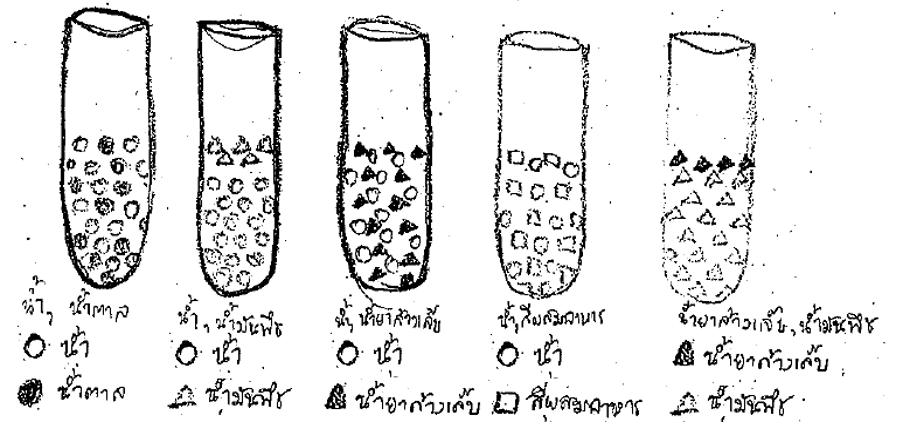การสำรวจความเข้าใจของนักเรียน เรื่อง สารละลาย
Main Article Content
บทคัดย่อ
วัตถุประสงค์ของการศึกษานี้เพื่อสำรวจความเข้าใจและความพึงพอใจของนักเรียน เรื่อง สารละลาย กลุ่มตัวอย่างที่ใช้ในการศึกษาครั้งนี้เป็นนักเรียนชั้นมัธยมศึกษาปีที่ 4 จำนวน 37 คน ซึ่งกำลังเรียน เรื่อง สารละลาย เครื่องมือที่ใช้ในเก็บรวบรวมข้อมูลประกอบด้วยแบบทดสอบ ภาพแทนบรรยาย และแบบสอบถามความพึงพอใจ ผลการวิจัยแสดงให้เห็นว่านักเรียนส่วนใหญ่สามารถอธิบายความคิดรวบยอดของสารละลาย นอกจากนี้ นักเรียนยังสามารถต่อยอดความเข้าใจเรื่อง สารละลายในการอธิบายระดับมหภาคและระดับสัญลักษณ์ได้เป็นอย่างดี อย่างไรก็ตาม นักเรียนยังคงมีปัญหาในการอธิบายระดับจุลภาค การวิจัยครั้งนี้แสดงให้เห็นว่าการบรรยายภาพแทนบรรยาย 3 ระดับน่าจะเป็นการเพิ่มประสบการณ์ที่สนุกสนานสำหรับนักเรียนและหันมาสนใจการเรียน เรื่อง สารละลายมากขึ้น
Article Details
วารสารวิทยาศาสตร์และวิทยาศาสตร์ศึกษา (JSSE) เป็นผู้ถือลิสิทธิ์บทความทุกบทความที่เผยแพร่ใน JSSE นี้ ทั้งนี้ ผู้เขียนจะต้องส่งแบบโอนลิขสิทธิ์บทความฉบับที่มีรายมือชื่อของผู้เขียนหลักหรือผู้ที่ได้รับมอบอำนาจแทนผู้เขียนทุกนให้กับ JSSE ก่อนที่บทความจะมีการเผยแพร่ผ่านเว็บไซต์ของวารสาร
แบบโอนลิขสิทธิ์บทความ (Copyright Transfer Form)
ทางวารสาร JSSE ได้กำหนดให้มีการกรอกแบบโอนลิขสิทธิ์บทความให้ครบถ้วนและส่งมายังกองบรรณาธิการในข้อมูลเสริม (supplementary data) พร้อมกับนิพนธ์ต้นฉบับ (manuscript) ที่ส่งมาขอรับการตีพิมพ์ ทั้งนี้ ผู้เขียนหลัก (corresponding authors) หรือผู้รับมอบอำนาจ (ในฐานะตัวแทนของผู้เขียนทุกคน) สามารถดำเนินการโอนลิขสิทธิ์บทความแทนผู้เขียนทั้งหมดได้ ซึ่งสามารถอัพโหลดไฟล์บทความต้นฉบับ (Manuscript) และไฟล์แบบโอนลิขสิทธิ์บทความ (Copyright Transfer Form) ในเมนู “Upload Submission” ดังนี้
1. อัพโหลดไฟล์บทความต้นฉบับ (Manuscript) ในเมนูย่อย Article Component > Article Text
2. อัพโหลดไฟล์แบบโอนลิขสิทธิ์บทความ (Copyright Transfer Form) ในเมนูย่อย Article Component > Other
ดาวน์โหลด ไฟล์แบบโอนลิขสิทธิ์บทความ (Copyright Transfer Form)
เอกสารอ้างอิง
ณัชธฤต เกื้อทาน ชาตรี ฝ่ายคำตา และสุดจิต สงวนเรือง. (2554). แบบจำลองความคิดเรื่องพันธะเคมีของนักเรียนชั้นมัธยมศึกษาปีที่ 4. วารสารสงขลานครินทร์ ฉบับสังคมศาสตร์และมนุษย์ศาสตร์, 17(2), 300-314.
นุชจิรา แดงวันสี ปริญวรรณ สุนทรักษ์ สนธิ พลชัยยา และกานต์ตะรัตน์ วุฒิเสลา. (2561). ผลการจัดการเรียนรู้แบบร่วมมือกับแอปพลิเคชันบนระบบปฏิบัติการแอนดรอยด์ที่มีต่อผลสัมฤทธิ์ทางการเรียน เรื่องตารางธาตุ สำหรับนักเรียนชั้นมัธยมศึกษาปีที่ 4. วารสารวิทยาศาสตร์และวิทยาศาสตร์ศึกษา, 1(1), 61-73.
สถาบันส่งเสริมการสอนวิทยาศาสตร์และเทคโนโลยี. (2546). คู่มือครูสาระการเรียนรู้พื้นฐานและเพิ่มเติม เคมี เล่ม 2 กลุ่มสาระการเรียนรู้วิทยาศาสตร์ ชั้นมัธยมศึกษาปีที่ 4 หลักสูตรสถานศึกษาขั้นพื้นฐาน พุทธศักราช 2544. กรุงเทพฯ: สถาบันส่งเสริมการสอนวิทยาศาสตร์และเทคโนโลยี.
สำนักงานการศึกษาขั้นพื้นฐาน. (2551). หลักสูตรแกนกลางการศึกษาขั้นพื้นฐาน พุทธศักราช 2551. กรุงเทพฯ: สำนักงานการศึกษาขั้นพื้นฐาน กระทรวงศึกษาธิการ.
Adadan, E., Irving, K. E. and Trundle, K. C. (2009). Impacts of multi-representational instruction on high school students' conceptual understandings of the particulate nature of matter. International Journal of Science Education, 31(13), 1743-1775.
Çalik, M. and Ayas, A. (2005). A comparison of level of understanding of eighth-grade students and science student teachers related to selected chemistry concepts. Journal of Research in Science Teaching, 42, 638-67.
Chandrasegaran, A. L., Treagust, D. F. and Mocerino, M. (2007). An evaluation of a teaching intervention to promote students’ ability to use multiple levels of representation when describing and explaining chemical reactions. Research in Science Education, 38, 237-248.
Coll, R. K., Jansoon, N., Dahsah, C. and Chairam, S. (2010a). Fostering teacher innovation in chemistry teaching in Thailand: Helping Thai science teachers move towards a learner-centred student classroom. In M. V. Zuljan and J. Vogrinc (Eds.), Facilitating effective student learning through teacher research and innovation (pp. 193-223). Ljubljana, Slovenia: Faculty of Education, University of Ljubljana.
Coll, R. K., Dahsah, C., Jansoon, N., and Chairam, S. (2010b). Fostering active chemistry learning in Thailand: Toward a learner-centered student experiences. In I. Devetak, & S. A. Glazar (Eds.), Learning with Understanding in the Chemistry Classroom (pp. 305-344). Springer: Dordrecht.
Dahsah, C. and Coll, R. K., (2007). Thai Grade 10 and 11 students' conceptual understanding and ability to solve stoichiometry problems. Research in Science & Technological Education, 25(2), 227-241.
Dahsah, C. and Coll, R. K., (2008). Thai grade 10 and 11 students’ understanding of stoichiometry and related concepts. International Journal of Science and Mathematics Education, 6, 573-600.
Davidowitz, B. and Rollnick, M. (2005). Development and application of a rubric for analysis of novice students’ laboratory flow diagrams. International Journal of Science Education, 27(1), 43-59.
Gilbert, J. K. and Treagust, D. F. (2009). Introduction: Macro, submicro and symbolic representations and the relationship between them: Key models in chemical education. In J. K. Gilbert and D. Treagust (eds.), Multiple Representations in Chemical Education, Models and Modeling in Science Education (pp. 1-8). Springe.
Jansoon, N., Coll, R. K. and Somsook, E. (2009). Understanding mental models of dilution in Thai students. International Journal of Environmental and Science Education, 4(2), 147-168.
National Research Council. (1996). National science education standards. Washington, DC: National Academy Press.
National Research Council. (2000). Inquiry and the National Science Education Standards: A Guide for Teaching and Learning. Washington, DC: National Academy Press.
Prain, V., Tytler, R. and Peterson, S. (2009). Multiple representations in learning about evaporation. International Journal of Science Education, 31(6), 787-808.


